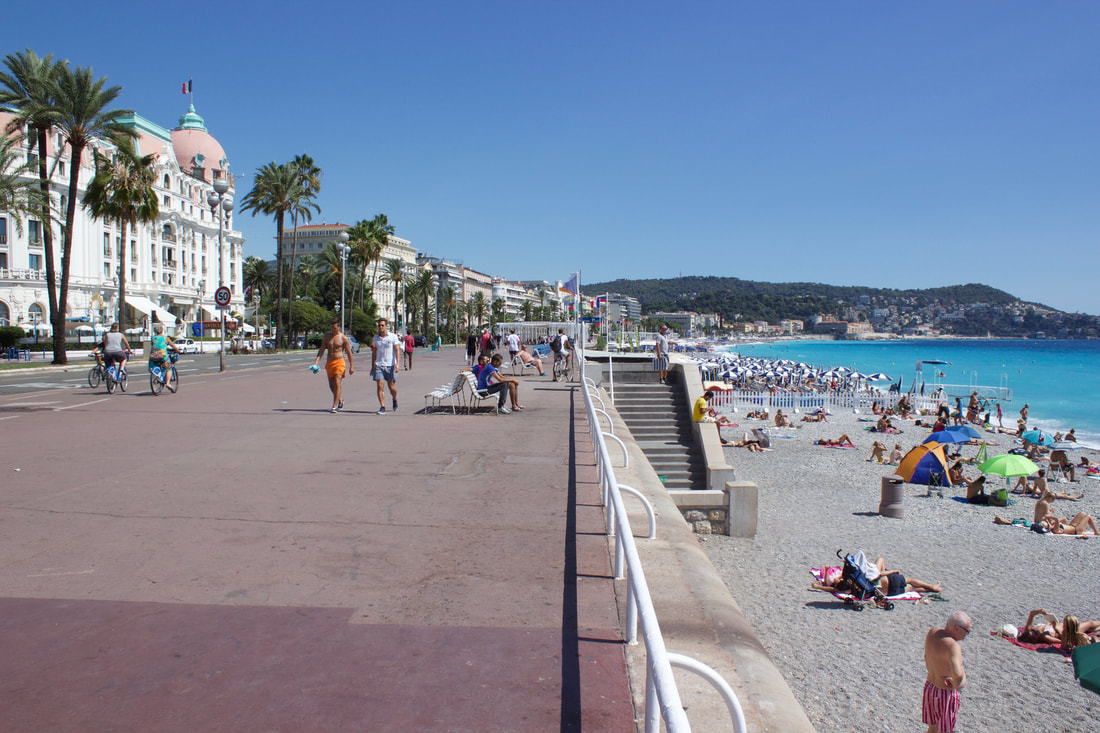The Old Town of Nice (Vieille Ville), also called Old Nice (Vieux Nice) sits nearby the Mediterranean just below Castle Hill. Old Town is where most people spend their time and for good reason. The streets comprise of old tenements, churches, plazas and squares filled with street side cafes and shops. It is easy to get lost in the narrow, shadowed, cobblestone streets that meander around town. Besides an array of shopping and culinary adventures, this is the area to discover some of the most vibrant buildings, displaying a mix of warm and cool-colored hues.
Some major points of interest include:
La Place Rossetti - The most notable square in Nice that features the architectural wonder, the Nice Cathedral. This is one of the most notable and bustling squares in Nice, and for a good reason, since it is one of the most picturesque and represents the life and culture of Nice.
False Gate - The marble gate is the gateway to the newer part of the city.
The Cathedral of St. Reparata - This 17th Century cathedral's dome is visible from Castle Hill. Inside are the remains of Saint Reparata, the patron saint of Nice.
Other churches exist and various markets pop up at times in Old Town. It is easy to get "lost" to explore the various shops, cafes, churches and relics. Travelers find a variety of French favorite shops from antique stores to French soaps and spices to tablecloths and handmade aprons.
I recommend a half day to experience the best of Old Town.
Norte Dame Church
Located in city center is the largest church in Nice, the Norte Dame. Similar to the Norte Dame in Paris, this church was built after Nice became French between 1864-1868. It became the first modern religious structure, but adheres to relics of the past with scenes from the Assumption, featuring 19th Century stained glass windows and two square towers.
Besides Old Town, Castle Hill is another must-visit attraction in Nice not only for the fantastic views, but to discover Nice's ancient past. This hill divides the seaside of Nice into two parts, the eastern part with the port and the western part with Old Town. The castle and the cathedral was first mentioned in the 11th Century where these buildings were once the center of town.
Before this, the Greeks lived in Nice, calling their 4th Century settlement Nikaia. Walking up Castle Hill one notices the remains of Greek artwork as well as the defensive walls. The castle was demolished in 1706 thanks to the commands of King Louis XIV, and the ruins are still visible today.
Everyday at noon a cannon fires on the top of the hill. Legend has it Sir Thomas Coventry-More, firing his cannon, notified his wife to come back from the city center for lunch. There are two historic cemeteries to explore on the top of the hill, one being Jewish, the other Catholic. On top of the hill are two panoramic view points, one overlooking Old Town and the other overlooking the port.
Cimiez
This neighborhood in Nice contains the ruins of the Roman town, Cemenelum. Founded in the 1st Century, this area was a staging post for Roman troops in the Alpes Maritime region, which later became the capital. Ruins include Roman baths, amphitheater and arena.
The area was also once visited by beloved artists such as Matisse. The Museum Matisse houses the artist's work, belongings and historical artifacts. Today, people roam the neighborhood to admire Belle Époque architecture. Visit The grand Boulevard de Cimiez to marvel at the luxury historic hotels built throughout the Victorian Era. One of the most notable is the 1908 Grand Hotel.
Discover more beauty and charm at the Park Arènes and Cimiez Monastery, which has homed Franciscan monks since the 16th Century. The Cimiez cemetery includes burial remains of Matisse, French painter, Raoul Dufy, Russian and British diplomats as well as the 1937 Nobel Prize winner for Literature, Roger Martin du Gard.
One cannot visit Nice without walking on the famous seaside footpath. According to the Nice Tourism website, "Originally a footpath no more than 6 feet wide, it was widened by an Englishman, Reverend Lewis Way, at his expense in 1820 and the local population soon dubbed it ‘Chemin des Anglais’. In 1931, when it was given its final form with two roadways separated by a central reservation planted with palm trees, the ‘Prom’ was inaugurated by the Duke of Connaught, one of Queen Victoria’s sons."
Le Negresco
As seen in the image, this Belle-Epoque is the only landmark in Nice that is a hotel and a museum. Built in 1912, the hotel features 121 rooms and 24 suites, each decorated in their own style ranging from modern art to Louis XIII style. The museum contains five centuries of art history and rated a five-star hotel. Some claim this is one of the most prominent hotels worldwide.
What's your favorite historical spot in Nice, France?
This Lemon Tree article is now featured on GPSmyCity. To download this article for offline reading or travel directions to the attractions highlighted in this article, go to Must-Visit Historical Attractions in Nice, France.
Let's Connect!








 RSS Feed
RSS Feed